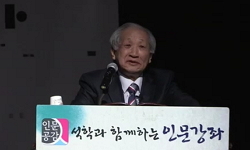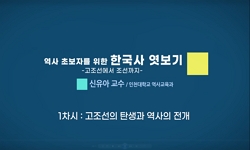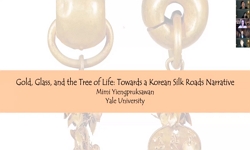본고는 처용설화의 주제를 ‘僻邪進慶’이라 파악하고, 이 주제가 드러나는 여러 경로를 살펴 처용과 疫神의 실체를 밝히기로 하였다. 전근대인은 과학적 의학 지식이 없어 질병은 귀신이 ...
http://chineseinput.net/에서 pinyin(병음)방식으로 중국어를 변환할 수 있습니다.
변환된 중국어를 복사하여 사용하시면 됩니다.
- 中文 을 입력하시려면 zhongwen을 입력하시고 space를누르시면됩니다.
- 北京 을 입력하시려면 beijing을 입력하시고 space를 누르시면 됩니다.

신라시대의 학질 퇴치 민간요법—처용설화 해석의 한 단서— = A folk treatment of malaria in Silla period: Clue to the interpretation of the Cheoyong tale
한글로보기부가정보
국문 초록 (Abstract)
처용설화는 신라시대 학질 치료에서 발생한 설화이다. 처용은 강력한 逐鬼 능력을 가졌는데, 처에게 침입한 학질 귀신을 歌舞로써 퇴치하였다. 신라인은 그를 역신을 물리치는 神人으로 추앙하여 門神으로 삼고, 處容歌와 處容舞를 지어 벽사진경을 축원하였다. 이후 처용가와 처용무는 고려-조선시대 궁중에서 거행하는 儺禮에서 벽사진경 축원으로 연행되었다. 처용가는 조선 세종조에 가사를 鳳凰吟으로 바꾸어 왕실의 안녕과 백성의 행복을 축원하는 국가적 벽사진경으로 승화되었다. 처용무는 벽사를 상징하는 복숭아, 진경을 상징하는 모란을 장식한 가면을 쓰고 조선 말기까지 궁중에서 연행되었다.
이처럼 처용설화는 신라인의 질병에 대한 인식과, 이에 따른 벽사진경 염원, 그리고 이 염원을 형상화 한 처용가와 처용무의 흐름을 살펴야 비로소 이해할 수 있다.
본고는 처용설화의 주제를 ‘僻邪進慶’이라 파악하고, 이 주제가 드러나는 여러 경로를 살펴 처용과 疫神의 실체를 밝히기로 하였다. 전근대인은 과학적 의학 지식이 없어 질병은 귀신이 인체에 침입해서 발생한다고 생각했다. 그러므로 질병 치유는 이 귀신을 驅逐하는 일이었다. 현대의 1920년대 말 사례조사에서도 그 방법이 무수하게 채집되었다.
처용설화는 신라시대 학질 치료에서 발생한 설화이다. 처용은 강력한 逐鬼 능력을 가졌는데, 처에게 침입한 학질 귀신을 歌舞로써 퇴치하였다. 신라인은 그를 역신을 물리치는 神人으로 추앙하여 門神으로 삼고, 處容歌와 處容舞를 지어 벽사진경을 축원하였다. 이후 처용가와 처용무는 고려-조선시대 궁중에서 거행하는 儺禮에서 벽사진경 축원으로 연행되었다. 처용가는 조선 세종조에 가사를 鳳凰吟으로 바꾸어 왕실의 안녕과 백성의 행복을 축원하는 국가적 벽사진경으로 승화되었다. 처용무는 벽사를 상징하는 복숭아, 진경을 상징하는 모란을 장식한 가면을 쓰고 조선 말기까지 궁중에서 연행되었다.
이처럼 처용설화는 신라인의 질병에 대한 인식과, 이에 따른 벽사진경 염원, 그리고 이 염원을 형상화 한 처용가와 처용무의 흐름을 살펴야 비로소 이해할 수 있다.
다국어 초록 (Multilingual Abstract)
This study identified the theme of Byeoksa-jingyeong's tale (僻邪進慶) and decided to reveal the true nature of Cheoyong and Yeoksin (疫神) by examining the various paths through which this theme was revealed.
In order to approach the theme of the tale, it is necessary to be aware of the diseases of pre-modern people. Since they had no scientific medical knowledge, they thought that diseases were caused by ghosts invading the human body. Therefore, curing a disease meant constructing a ghost that carried it. This ghost-deafeating folklore was collected countless times during case studies in the late 1920s.
The Cheoyong tale is a tale that arose from the treatment of Malaria (瘧疾) during the Silla Dynasty. In other words, Cheoyong had a powerful ability to exorcise demons, and he exorcised the Malaria-carring ghost that invaded his wife by singing and dancing. The peoples of Silla revered him who defeated the gods of evil, and composed Cheoyongga (處容歌) and Cheoyongmu (處容舞) to pray for Byeoksa-jingyeong. Until today, the interpretation of Cheoyongga as Cheoyong's wife's adultery was an error in literally interpreting the comical expression in Cheoyongga that interprets the invasion of a Malaria-carring ghost on a woman as 'copulation'.
In this way, the Silla people recognized Cheoyong as the cure for all diseases, and thus he became a symbol of Byeoksa-jingyeong. Afterwards, Cheoyongga and Cheoyongmu were performed as Byeoksa-jingyeong congratulations at royal ceremonies during the Goryeo-Joseon Dynasty. King Sejong of the Joseon Dynasty changed Cheoyongga to Bonghwangum (鳳凰吟), and the people's Byeoksa-jingyeong was sublimated into a national Byeoksa-jingyeong for the well-being of the royal family and the happiness of the people. Cheoyongmu was performed at the royal court until the end of the Joseon Dynasty, wearing masks decorated with peaches, symbolizing Byeoksa, and peonies, symbolizing Jingyeong.
In this way, the Cheoyong tale is a strange story that can only be understood by looking at the awareness of pre-modern people since the Silla Dynasty on disease, the resulting wish for Byeoksa-jingyeong, and the flow of Cheoyongga and Cheoyongmu that embody this wish.
The Cheoyong tale (處容說話) is a mysterious story included in the strange edition of Samgukyusa (三國遺事), so it is difficult to understand it as a historical reality. This is the reason why there are so many research achievements that it i...
The Cheoyong tale (處容說話) is a mysterious story included in the strange edition of Samgukyusa (三國遺事), so it is difficult to understand it as a historical reality. This is the reason why there are so many research achievements that it is difficult to count them.
This study identified the theme of Byeoksa-jingyeong's tale (僻邪進慶) and decided to reveal the true nature of Cheoyong and Yeoksin (疫神) by examining the various paths through which this theme was revealed.
In order to approach the theme of the tale, it is necessary to be aware of the diseases of pre-modern people. Since they had no scientific medical knowledge, they thought that diseases were caused by ghosts invading the human body. Therefore, curing a disease meant constructing a ghost that carried it. This ghost-deafeating folklore was collected countless times during case studies in the late 1920s.
The Cheoyong tale is a tale that arose from the treatment of Malaria (瘧疾) during the Silla Dynasty. In other words, Cheoyong had a powerful ability to exorcise demons, and he exorcised the Malaria-carring ghost that invaded his wife by singing and dancing. The peoples of Silla revered him who defeated the gods of evil, and composed Cheoyongga (處容歌) and Cheoyongmu (處容舞) to pray for Byeoksa-jingyeong. Until today, the interpretation of Cheoyongga as Cheoyong's wife's adultery was an error in literally interpreting the comical expression in Cheoyongga that interprets the invasion of a Malaria-carring ghost on a woman as 'copulation'.
In this way, the Silla people recognized Cheoyong as the cure for all diseases, and thus he became a symbol of Byeoksa-jingyeong. Afterwards, Cheoyongga and Cheoyongmu were performed as Byeoksa-jingyeong congratulations at royal ceremonies during the Goryeo-Joseon Dynasty. King Sejong of the Joseon Dynasty changed Cheoyongga to Bonghwangum (鳳凰吟), and the people's Byeoksa-jingyeong was sublimated into a national Byeoksa-jingyeong for the well-being of the royal family and the happiness of the people. Cheoyongmu was performed at the royal court until the end of the Joseon Dynasty, wearing masks decorated with peaches, symbolizing Byeoksa, and peonies, symbolizing Jingyeong.
In this way, the Cheoyong tale is a strange story that can only be understood by looking at the awareness of pre-modern people since the Silla Dynasty on disease, the resulting wish for Byeoksa-jingyeong, and the flow of Cheoyongga and Cheoyongmu that embody this wish.
동일학술지(권/호) 다른 논문
-
정묘호란 이후 조선에 대한 명의 貢路⋅貢期 변경 및 조공사행 통제 강화
- 고려대학교 민족문화연구원
- 이재경
- 2024
- KCI등재
-
- 고려대학교 민족문화연구원
- 배정상
- 2024
- KCI등재
-
언어정화(말다듬기) 정책의 논리 구축 과정에서 북한 지도이념과 어문민족주의의 상호작용 양상
- 고려대학교 민족문화연구원
- 최경봉
- 2024
- KCI등재
-
- 고려대학교 민족문화연구원
- 최다정
- 2024
- KCI등재




 KCI
KCI KISS
KISS






